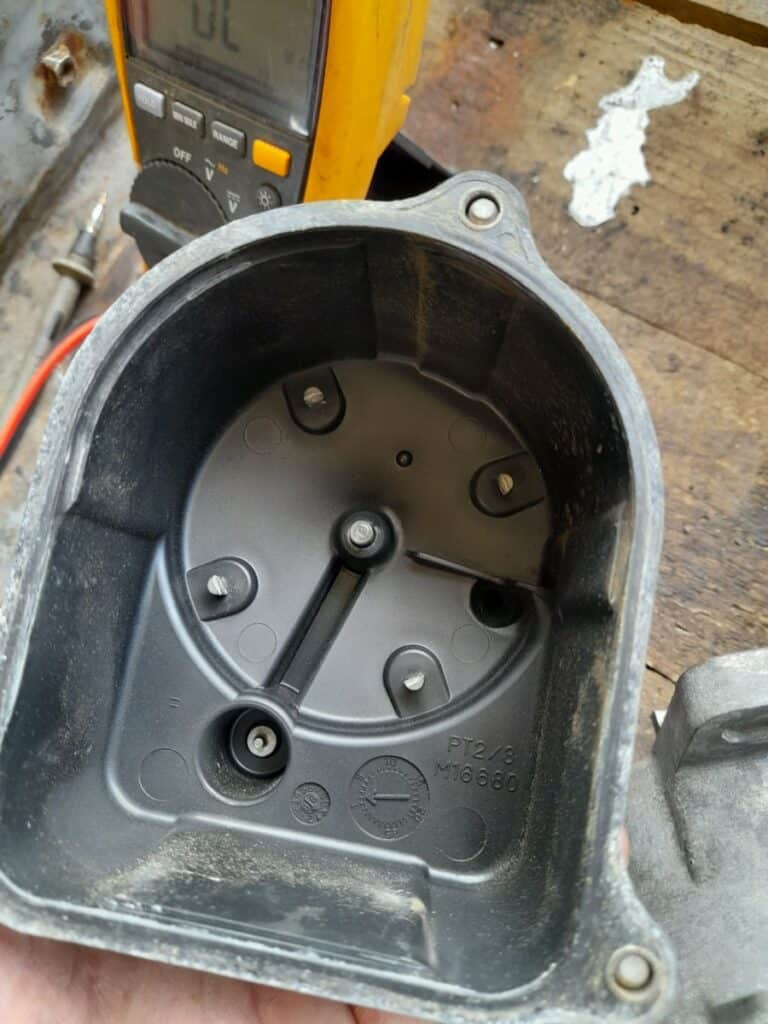A Honda is a fantastic car for both reliability and comfort, but unfortunately, they are not without their flaws. A common problem I see with Hondas is distributor failure. Luckily this is a relatively simple issue to diagnose and fix once you figure out exactly which component is faulty. This article covers the most common Honda distributor problems.
A Cracked Distributor Cap
A cracked distributor cap is usually the most common cause of failure when it comes to a Honda distributor. The distributor cap or rotor cap, as it is also known, is made from plastic. Once this plastic is exposed to heat from the engine over a long period, the heat will cause the plastic to become brittle due to a change in the grain structure of the plastic, which will then eventually crack.

When the rotor cap is cracked it can allow water or rain to enter the distributor, which will cause a severe engine misfire or not allow the engine to start at all.
If the rotor cap is cracked you might notice the engine runs rough or sounds lumpy in wet weather, or you might notice the car being hard to start after a car wash. This is due to moisture creeping into the distributor cap and not allowing the spark to travel as it should.
Along with cracking, there is also a rubber seal that goes around the cap to seal it with the distributor. This seal often becomes worn which also allows ingress of water and moisture.
Luckily a new distributor cap will only set you back $20 and you can replace the cap easily at home by using an 8mm spanner. Here is an easy to follow article that will walk you through testing and replacing your distributor cap.
Faulty Ignition Coil
The ignition coil is a common problem with Honda distributors and a likely culprit if the car stalls and refuses to restart or just fails to start at all. The ignition coil acts as a step-up transformer, which means the coil is powered by a 12 volt DC power supply from the car battery.
This 12v then travels through a series of coils of wire, known as the primary and secondary windings, which then produce a massive 22,000 volts, this 22,000v then flows through the HT plug leads, into the spark plugs causing spark at the cylinders.

The ignition coil has a life span of about 120,000 miles. Due to the massive amounts of energy and heat passing through the windings, the fine wires of the windings or the resin coating which insulates the windings eventually break down causing an open or short circuit.
For a more detailed breakdown of how an ignition coil works you should check out this article I wrote recently.
The ignition coil is found inside the distributor itself and is only visible by removing the distributor cap. A new ignition coil will cost you about $50 and it can be replaced pretty easily in about 30 minutes. But before you go buying a new one you need to be sure to check out this article on how to test an ignition coil, to be 100% sure the coil is the problem.
Faulty Ignitor
The Ignitor inside a Honda distributor is the component that controls the spark timing of each cylinder, by switching power on and off to the ignition coil at a very high speed.

The ignitor works by receiving a signal from the camshaft sensor telling it when the optimal spark timing is, based on the position of the camshaft, along with other factors such as load and speed, etc. Once the ignitor receives the signal it then shuts off the flow of current to the ignition coil.
This sudden drop in voltage collapses the magnetic field surrounding the primary and secondary windings, therefore, allowing the high voltage current to discharge through the plug leads and into the spark plugs.
This process happens about 1000 times a second and any variation in the process would cause a misfire in the engine of the car. The good news is the ignitor is easily diagnosed and you can buy a replacement for between $30 to $40 online or at your local auto parts store.
If you think your ignitor needs to be replaced you should check out this article on testing a Honda ignitor first before you buy.
Worn Rotor Arm
A worn rotor arm is a common problem in all distributors not only Honda. This is because it’s a wearing part that breaks down over time.

The rotor arm works by spinning inside the distributor cap at the same RPM as the camshaft. While the rotor arm is spinning, the ignition coil is producing an output voltage of 22,000 volts which flows through the spring terminal of the coil (spring as seen in the photo above), the spring terminal is in direct contact with a terminal on the distributor cap (terminal to the bottom left seen in photo below).
This voltage is then distributed to the four pickup terminals around the distributor cap via the spinning rotor arm, making it possible for current to flow to the spark plugs through the HT leads.

A rotor arm has a life span of around 100,000 miles due to the conductive point of the rotor arm becoming worn making the slight air gap to large for the spark to jump. It will only cost you about $20 to buy a new rotor arm.
If you’re changing the arm yourself it shouldn’t take you longer than 30 minutes to complete, all you need is a big Philips head screwdriver and an 8mm wrench. For more information on how to remove the arm iv written a helpful article on removing your rotor arm.
Conclusion
Although Honda distributors come with their problems they are still a reliable unit considering there are very few reports of premature failure, you also need to bear in mind, that everything comes with a certain life span.
Luckily replacement parts for Honda distributors are easily got including a complete new distributor for approximately $250 which is an excellent price considering the equipment it’s manufactured from.
Recent Posts
As much as I and everyone else love turbochargers there is one problem most people have with using them, turbo lag. Turbo lag is a hesitation or unresponsiveness which may be felt as a slow...
Last week a friend of mine arrived in my shop with a Garrett 3076R turbocharger and asked me if I could install it in a stock Miata MX5 because he wanted to more power out of corners on the track....
